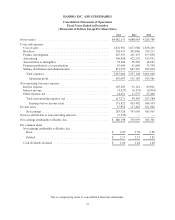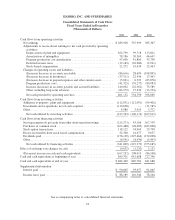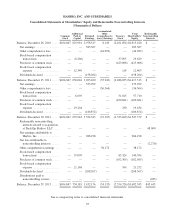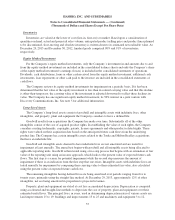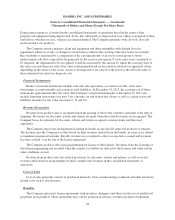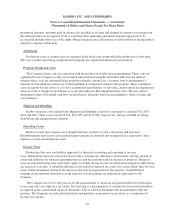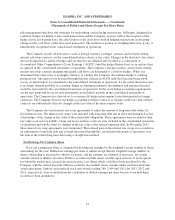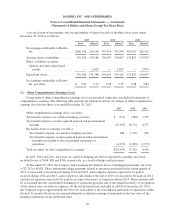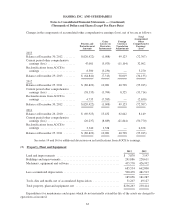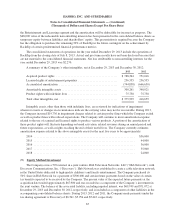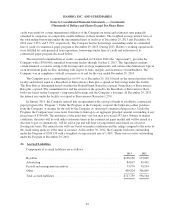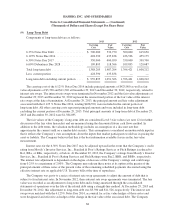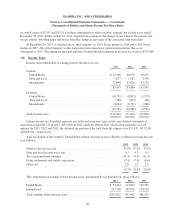Hasbro 2013 Annual Report Download - page 71
Download and view the complete annual report
Please find page 71 of the 2013 Hasbro annual report below. You can navigate through the pages in the report by either clicking on the pages listed below, or by using the keyword search tool below to find specific information within the annual report.
HASBRO, INC. AND SUBSIDIARIES
Notes to Consolidated Financial Statements — (Continued)
(Thousands of Dollars and Shares Except Per Share Data)
guaranteed amounts. Amounts paid in advance are recorded as an asset and charged to expense as revenue from
the related products is recognized. If all or a portion of the minimum guaranteed amounts appear not to be
recoverable through future use of the rights obtained under license, the non-recoverable portion of the guaranty is
charged to expense at that time.
Advertising
Production costs of commercials are expensed in the fiscal year during which the production is first aired.
The costs of other advertising and promotion programs are expensed in the fiscal year incurred.
Program Production Costs
The Company incurs costs in connection with the production of television programming. These costs are
capitalized by the Company as they are incurred and amortized using the individual-film-forecast method,
whereby these costs are amortized in the proportion that the current year’s revenues bear to management’s
estimate of total ultimate revenues as of the beginning of such period related to the program. These capitalized
costs are reported at the lower of cost, less accumulated amortization, or fair value, and reviewed for impairment
when an event or change in circumstances occurs that indicates that impairment may exist. The fair value is
determined using a discounted cash flow model which is primarily based on management’s future revenue and
cost estimates.
Shipping and Handling
Hasbro expenses costs related to the shipment and handling of goods to customers as incurred. For 2013,
2012 and 2011, these costs were $155,316, $157,035 and $173,028, respectively, and are included in selling,
distribution and administration expenses.
Operating Leases
Hasbro records lease expense on a straight-line basis inclusive of rent concessions and increases.
Reimbursements from lessors for leasehold improvements are deferred and recognized as a reduction to lease
expense over the remaining lease term.
Income Taxes
Hasbro uses the asset and liability approach for financial accounting and reporting of income
taxes. Deferred income taxes reflect the net tax effect of temporary differences between the carrying amount of
assets and liabilities for financial reporting purposes and the amounts used for income tax purposes. Deferred
taxes are measured using rates expected to apply to taxable income in years in which those temporary differences
are expected to reverse. A valuation allowance is provided for deferred tax assets if it is more likely than not such
assets will be unrealized. Deferred income taxes have not been provided on the majority of undistributed
earnings of international subsidiaries as the majority of such earnings are indefinitely reinvested by the
Company.
The Company uses a two step process for the measurement of uncertain tax positions that have been taken
or are expected to be taken in a tax return. The first step is a determination of whether the tax position should be
recognized in the consolidated financial statements. The second step determines the measurement of the tax
position. The Company records potential interest and penalties on uncertain tax positions as a component of
income tax expense.
59





